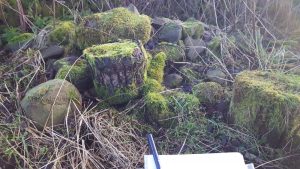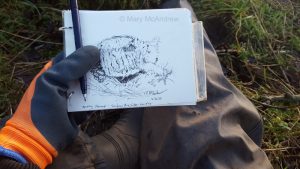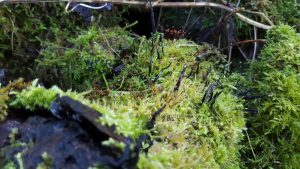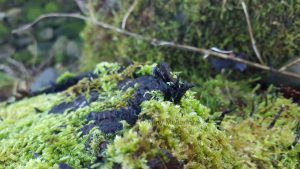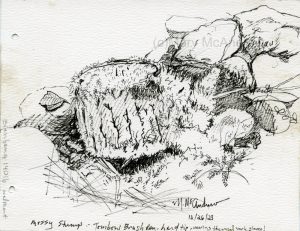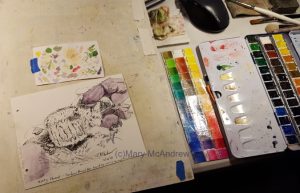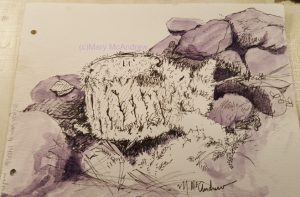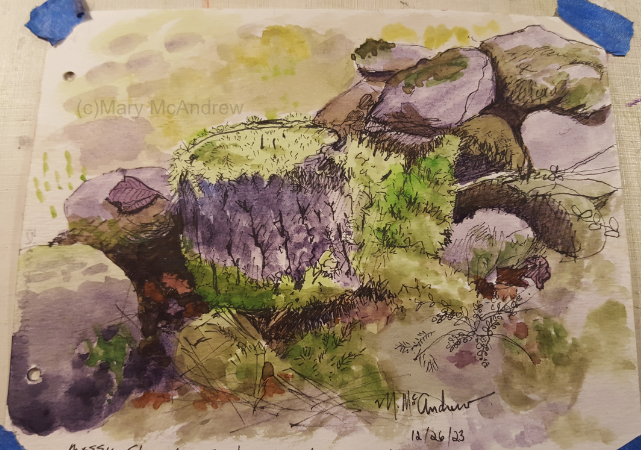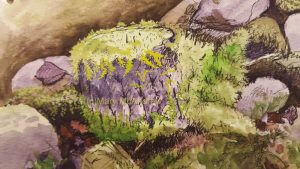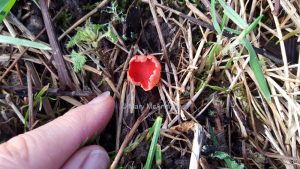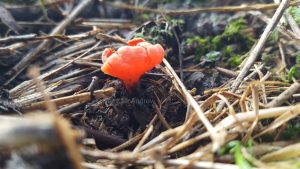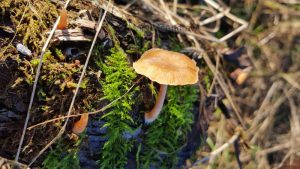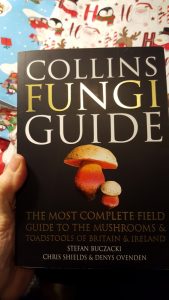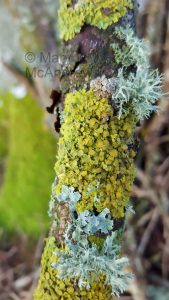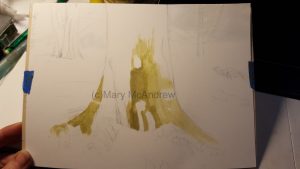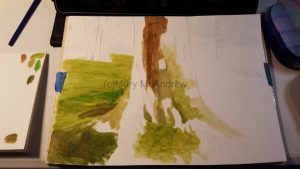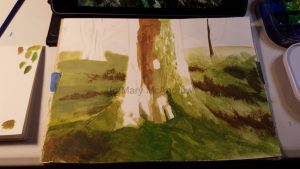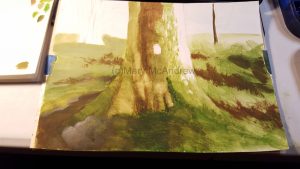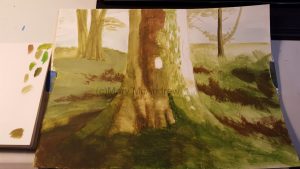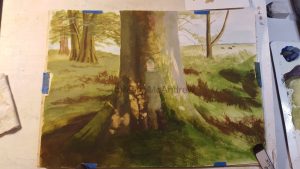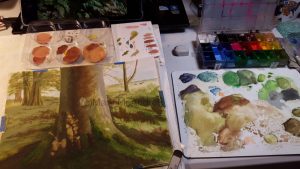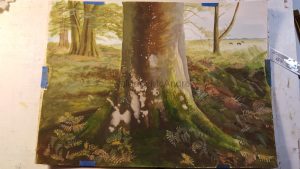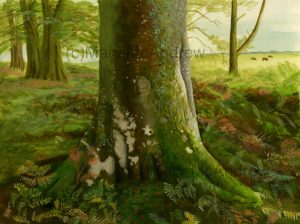(Click on any picture to see it enlarged)
I did this study back at the end of December, the sketch was done outside and I painted it near the woodstove heat at night! I’ve included lots of pictures to show some stages of painting and other fungi I found.
This is the view I had from my place on the damp, cold ground. It’s just a pile of rocks and old stumps but I’m drawn to the deep cracks and crevices that connect them all like a puzzle. When I draw this kind of subject, I usually get a bit lost with all the crevices and rocks, but being that it’s a natural subject, you can just adjust it as needed so it looks ok.
Above shows the size of my sketchpad and the thick thermal gloves I wore. I also had my rubber gardening pants and Wellies on because it was so cold and wet on the ground.
The pictures above and below show the interesting fungi that grows out of the stump. The fungi is either Xylaria polymorpha (Deadman’s Fingers, what a name eh?) or Xylaria longpipes. The guide says Xylaria, “look for: hard, tough, usually dark brown to black, clustered finger-like fruit body on dead wood.” Well the black fungi on this stump is much skinnier than what the book shows, but maybe it’s because it swells up at a certain time of year?
This is the sketch I did outside in my small field sketchbook. As it says on the bottom of the drawing, I wore thick, thermal work gloves while drawing, a difficult task! And I used a new pen I’ve not tried yet, “Tombow Brush Pen”, hard tip, I thought it would be better for making quick marks in the cold. I also bought the softer tip version, which is in my field bag to experiment with also.
Above shows my Van Gogh watercolor set, the color chart I did of each paint and the sketch on my board. I always keep a small bit of watercolor paper for testing colors nearby.
I used a color called “Moonglow” by Daniel Smith. It’s a dull purple color I’ve used before for underpainting rocks and like experimenting with it.
Above shows more layers of watercolors to build up colors.
Now that the watercolor layers are on I start to add gouache, which is opaque and is great for building up the texture of the moss. If you plan ahead, the gouache can really stand out nicely, especially on dark areas.
This is the study finished, I took this with my cell phone camera at night in regular lamp light, but the warm hue is pretty close to the original.
Every year, since we’ve moved to our property in the Scottish Borders, I’ve spotted this tiny Scarlet Elfcup growing. It springs up in Autumn under the huge ancient Ash tree in our paddock, but so small I have to be careful not to step on it. I picked up a few sticks and placed them to form a square around it, just to help me see it and not step on it.
This year I was lucky and found yet another little Scarlet Elfcup. I’m hoping it spreads more every year.
I don’t know what kind of mushroom this is on a fallen dead Hawthorn branch. You can see several stalks from others that broke off, they are quite small and delicate.
Here is a view from underneath the mushroom, showing the gills. I love the fine, soft looking white threads around it’s base, I’m not sure what they are.
This was my favorite present from my husband this Christmas, over the new clothes, treats and bath powders etc, I was so excited about getting this book! Does that make me a ‘Nature Nerd’?
The book is full of clear, well painted illustrations. The introduction is full of clear diagrams and information about fungi in general and it’s a great place to study to learn more about them. Though the book is well illustrated, I still find it very difficult to positively identify each mushroom I find. I belong to a group or two on Facebook for mushroom and fungi identification in the UK, I don’t know what I’d do without them!
This is a branch I picked up under the old Ash tree, covered with lichens. I’m learning more about lichens as they really are fascinating and beautiful, BUT I admit it’s super hard to identify different ones unless I share it on the Facebook lichens group where the experts can tell me what it is! I know there are different groups of lichens like Foliose, Crustose and Fruticose. I should’ve shared these pictures on the Facebook group to find out what kind these were, I will sometime. But as an artist the first thing I’m drawn to are the colors, the textures and form. I’m just fascinated as I look closer, at all the little cups and branches!
I mean look at all the tiny little round ‘plates’ on this lichen and then the difference in their colors. I love the limey green yellow color of the crusty one and the pale mint green of the branched foliose one. If I do some painting studies of lichens then I’ll find out the names of them too and share them. I bought a book on Lichens by Frank S. Dobson, but really it’s still waaaay over my head! I never knew there were so many kinds.
Well I guess that’s enough pictures and talk about mushrooms and lichens! Even though I don’t post updates a lot, I am working very hard on finishing up the first draft of my first Children’s Book. It’s all new to me so it’s taking much longer than it probably should! I’m also messing around with updating and changing things on my website and adding a proper shop, but these things take time when you do it all yourself. It’s frustrating when all I want to do is paint and admittedly work in the garden!
Please leave comments or ask questions, I love reading the comments from all over the world.
